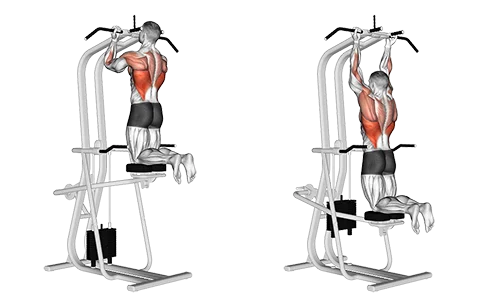Introduction
The Assisted Chin Up exercise involves using additional support to perform a chin up movement, making it easier for beginners or those with limited upper body strength. It primarily strengthens the back muscles, biceps, and shoulders, enhancing overall upper body strength and promoting good posture. This exercise is particularly effective for individuals aiming to improve their upper body strength in a controlled manner, gradually working towards unassisted chin ups as they progress.
Muscles Worked
- Primary: Biceps Brachii (Biceps), Latissimus Dorsi (Back Width)
- Secondary: Brachioradialis (Forearm Flexor), Teres Major (Back), Deltoid (Shoulder)
How to Do It (Step-by-Step)
- Stand under a pull-up bar with a shoulder-width grip. Your feet should not touch the ground.
- Hang from the bar and flex your core to prevent swinging.
- Slowly pull yourself up until your chin is above the bar, keeping your elbows close to your body. Lower yourself back down under control.
Tip: To make it easier, you can use an assisted machine or have a partner provide assistance on your legs. Always ensure proper form to avoid injury and maximize effectiveness.
Rep & Rest Guidelines
- Strength: 4–6 reps, 2–3 min rest
- Hypertrophy: 8–12 reps, 60–90 sec rest
- Endurance: 12–20 reps, 30–60 sec rest
Utilize Auto Progression for optimal progress and adaptability. Keep track of your exercises with the handy Rest Timer.
Form Tips
- Maintain a neutral spine and avoid rounding the back. Keep your core engaged throughout the exercise.
- Start with the bar or handles at a comfortable grip width, palms facing forward. Avoid gripping too tightly to prevent unnecessary strain.
- Pull up until your chin is over the bar or handles, keeping your elbows tucked in close to your body. Lower yourself slowly and controlled back to the starting position.
When to Use It
- For beginners learning chin-ups, using assisted chin-ups allows them to build strength and confidence.
- Rehabilitating from shoulder injuries, assisted chin-ups can help regain upper body strength while minimizing pain.
- Athletes looking to increase their maximum pull-up capacity can incorporate assisted chin-ups into their training for more resistance.
Workout History is essential for tracking your progress and adjusting your workout routine effectively.
Resistance bands or a dip assist machine can help you perform assisted chin ups.
Assisted chin ups help build upper body strength, particularly in the back and arms.
3-4 sets of 8-12 repetitions is a good starting point for building strength.
It's recommended to give your muscles time to recover, so train them 2-3 times per week at most.
Reduce the assistance gradually until you can do a full chin up without assistance.

